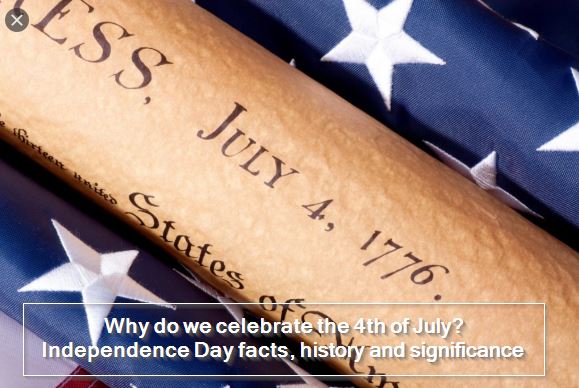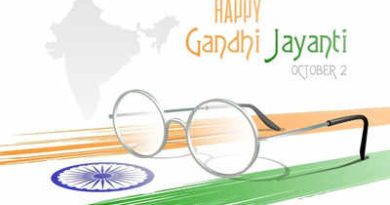Why do we celebrate the 4th of July? Independence Day facts, history and significance
4th July history | 4th of July History | 4th July in History
Independence day Americans | America’s Independence day |Independence day in America
July 4th is Independence Day, a time to show your patriotic pride.
The federal holiday marks the day in 1776 when the Second Continental Congress unanimously adopted the Declaration of Independence, signaling the official separation of the colonies from Great Britain amid the Revolutionary War.
Since that day, July 4, 1776 has been considered America’s “birthday,” making her 244 years old today.
According to the Library of Congress, Philadelphians marked the first anniversary of American independence with a celebration, but it wasn’t until after the War of 1812 that July 4th celebrations spread across the new nation.
The Fourth of July—also known as Independence Day or July 4th—has been a federal holiday in the United States since 1941, but the tradition of Independence Day celebrations goes back to the 18th century and the American Revolution. On July 2nd, 1776, the Continental Congress voted in favor of independence, and two days later delegates from the 13 colonies adopted the Declaration of Independence, a historic document drafted by Thomas Jefferson. From 1776 to the present day, July 4th has been celebrated as the birth of American independence, with festivities ranging from fireworks, parades and concerts to more casual family gatherings and barbecues. The Fourth of July 2020 is on Saturday, July 4, 2020.
[amazon box=”B07SDFC9QT” “small”]
Despite conspiracy theories and movies, there isn’t a secret map or code on the back of the Declaration of Independence. There are words, however. An unknown person wrote “Original Declaration of Independence dated 4th July 1776” on the back. It’s believed that was added as a label when the document was rolled up for storage.
Thomas Jefferson is often called the “author” of the Declaration of Independence, but he wasn’t the only person who contributed important ideas. Jefferson was a member of a five-person committee appointed by the Continental Congress to write the Declaration. The committee included Jefferson, Benjamin Franklin, John Adams, Robert Livingston, and Roger Sherman.
The Declaration of Independence wasn’t signed on July 4, 1776. In fact, independence was formally declared on July 2, 1776, a date that John Adams believed would be “the most memorable epocha in the history of America.” On July 4, 1776, Congress approved the final text of the Declaration. It wasn’t signed until August 2, 1776.
The two youngest signers of the Declaration of Independence were both from South Carolina. Thomas Lynch, Jr. and Edward Rutledge of South Carolina were both born in 1749 and were only 26 when they signed the Declaration. The oldest signer was Benjamin Franklin, who was born in 1706 and 70 at the time of the Declaration.
Thomas Jefferson and John Adams both died on July 4, 1826, the 50th anniversary of the vote to approve the Declaration of Independence.
A History of Independence Day | 4th July
Independence day Americans | America’s Independence day |Independence day in America
When the initial battles in the Revolutionary War broke out in April 1775, few colonists desired complete independence from Great Britain, and those who did were considered radical.
By the middle of the following year, however, many more colonists had come to favor independence, thanks to growing hostility against Britain and the spread of revolutionary sentiments such as those expressed in the bestselling pamphlet “Common Sense,” published by Thomas Paine in early 1776.
[amazon box=”B084VM3BHV” “small”]
On June 7, when the Continental Congress met at the Pennsylvania State House (later Independence Hall) in Philadelphia, the Virginia delegate Richard Henry Lee introduced a motion calling for the colonies’ independence.
Amid heated debate, Congress postponed the vote on Lee’s resolution, but appointed a five-man committee—including Thomas Jefferson of Virginia, John Adams of Massachusetts, Roger Sherman of Connecticut, Benjamin Franklin of Pennsylvania and Robert R. Livingston of New York—to draft a formal statement justifying the break with Great Britain.
Did you know? John Adams believed that July 2nd was the correct date on which to celebrate the birth of American independence, and would reportedly turn down invitations to appear at July 4th events in protest. Adams and Thomas Jefferson both died on July 4, 1826—the 50th anniversary of the adoption of the Declaration of Independence.
On July 2nd, the Continental Congress voted in favor of Lee’s resolution for independence in a near-unanimous vote (the New York delegation abstained, but later voted affirmatively). On that day, John Adams wrote to his wife Abigail that July 2 “will be celebrated, by succeeding Generations, as the great anniversary Festival” and that the celebration should include “Pomp and Parade…Games, Sports, Guns, Bells, Bonfires and Illuminations from one End of this Continent to the other.”
On July 4th, the Continental Congress formally adopted the Declaration of Independence, which had been written largely by Jefferson. Though the vote for actual independence took place on July 2nd, from then on the 4th became the day that was celebrated as the birth of American independence.
Early Fourth of July Celebrations
In the pre-Revolutionary years, colonists had held annual celebrations of the king’s birthday, which traditionally included the ringing of bells, bonfires, processions and speechmaking. By contrast, during the summer of 1776 some colonists celebrated the birth of independence by holding mock funerals for King George III as a way of symbolizing the end of the monarchy’s hold on America and the triumph of liberty.
Festivities including concerts, bonfires, parades and the firing of cannons and muskets usually accompanied the first public readings of the Declaration of Independence, beginning immediately after its adoption. Philadelphia held the first annual commemoration of independence on July 4, 1777, while Congress was still occupied with the ongoing war.
[amazon box=”B07NCRLGYH” “small”]
George Washington issued double rations of rum to all his soldiers to mark the anniversary of independence in 1778, and in 1781, several months before the key American victory at the Battle of Yorktown, Massachusetts became the first state to make July 4th an official state holiday.
After the Revolutionary War, Americans continued to commemorate Independence Day every year, in celebrations that allowed the new nation’s emerging political leaders to address citizens and create a feeling of unity. By the last decade of the 18th century, the two major political parties—the Federalist Party and Democratic-Republicans—that had arisen began holding separate Fourth of July celebrations in many large cities.
Fourth of July Fireworks
The first fireworks were used as early as 200 BC. The tradition of setting off fireworks on the 4 of July began in Philadelphia on July 4, 1777, during the first organized celebration of Independence Day. Ship’s cannon fired a 13-gun salute in honor of the 13 colonies. The Pennsylvania Evening Post reported: “at night there was a grand exhibition of fireworks (which began and concluded with thirteen rockets) on the Commons, and the city was beautifully illuminated.” That same night, the Sons of Liberty set off fireworks over Boston Common.
Fourth of July Becomes a Federal Holiday
The tradition of patriotic celebration became even more widespread after the War of 1812, in which the United States again faced Great Britain. In 1870, the U.S. Congress made July 4th a federal holiday; in 1941, the provision was expanded to grant a paid holiday to all federal employees.
Over the years, the political importance of the holiday would decline, but Independence Day remained an important national holiday and a symbol of patriotism.
Falling in mid-summer, the Fourth of July has since the late 19th century become a major focus of leisure activities and a common occasion for family get-togethers, often involving fireworks and outdoor barbecues. The most common symbol of the holiday is the American flag, and a common musical accompaniment is “The Star-Spangled Banner,” the national anthem of the United States.




